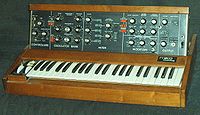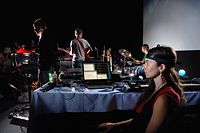
Quintephone
Encyclopedia


Steve Mann
Steven Mann , is a tenured professor at the Department of Electrical and Computer Engineering at the University of Toronto.-Education:...
, a Quintephone is a musical instrument
Musical instrument
A musical instrument is a device created or adapted for the purpose of making musical sounds. In principle, any object that produces sound can serve as a musical instrument—it is through purpose that the object becomes a musical instrument. The history of musical instruments dates back to the...
that generates sound informatically .
For Mann, electronic instruments, i.e. electrophones, are a proper subset of quintephones, but the category quintephone is necessary to describe computational sound synthesizers that operate by other-than-electrical means, such as synthesizers that work using optical computing.
The classification has still not been debated in organological studies.
Categories of quintephone
- ElectrophoneElectrophoneThe electrophone category was added to the Hornbostel-Sachs musical instrument classification system by Sachs in 1940, to describe instruments involving electricity...
s, i.e. electronic instruments; - Synthesizers based on optical computing;
- Synthesizers based on mechanical computing;
- Synthesizers based on life forms, neural networks, etc.;
- Physiologically generated music, e.g. electroencephalophoneElectroencephalophoneAn electroencephalophone or encephalophone is an experimental musical instrument or diagnostic tool which uses brain waves to generate or modulate sounds....
or electrocardiophoneElectrocardiophoneAn electrocardiophone or cardiophone is a musical instrument or diagnostic tool which uses heart waves to generate or modulate sounds....
.
Etymology
The name derives from Plato's and Aristotle's "fifth" Classical ElementClassical element
Many philosophies and worldviews have a set of classical elements believed to reflect the simplest essential parts and principles of which anything consists or upon which the constitution and fundamental powers of anything are based. Most frequently, classical elements refer to ancient beliefs...
after Earth (solids), Water (liquids), Air (gases), and Fire (plasmas). This fifth element, which they called "Idea" or quintessence (from "quint" meaning "fifth"), describes that which is beyond the material ("matter") world and its four states-of-matter. Quint is Latin for "fifth" and "phone" is Greek for "sound", so an alternative (all-Greek) name would be "pemptophone" (all Greek), but "quintephone" is used because the fifth Greek Classical Element is often now more commonly known and described in terms of the Latin "Quint" as "Quintessence" rather than "Pemptousia" (Greek for "fifth essence").
Instruments belonging to the fifth Hornbostel-Sachs category, "electrophones", added by Sachs in the 1940s (Kartomi, book reference) are quintephones, but a number of other instruments have been invented that synthesize sound, or record and play back sound samples, optically, mechanically, or otherwise. Some quintephones work entirely without using electricity in any way, and are thus certainly not electrophones, yet they generate sound computationally rather than acoustically.
Comparison with other instruments
Instruments generate sound either acoustically (from matter in its solid, liquid, gaseous, or higher-energy state), or informatically, from matter in its state of Quintessence (Quintessence, also known as Idea, was the fifth-classical element of Plato and Aristotle). http://itp.nyu.edu/nime/2007/proc/nime2007_118.pdfQuintessence-based sound production
Instruments that generate sound from quintessence (Idea) use some form of computation, algorithm, or calculative process, whether by analog circuits (as in the Theremin), by digital circuits (as in modern software synthesizers), by mechanical computing (as in the use of the phonograph disk as a sampling instrument), or by optical means (as in instruments like the OptiganOptigan
The Optigan was an electronic keyboard instrument designed for the consumer market. The name stems from the instrument's reliance on pre-recorded optical soundtracks to reproduce sound...
).
- Electronic instruments generate sound through electronic means. They often mimic other instruments in their design, particularly keyboards, drums and guitars. Examples: synthesizerSynthesizerA synthesizer is an electronic instrument capable of producing sounds by generating electrical signals of different frequencies. These electrical signals are played through a loudspeaker or set of headphones...
s and thereminThereminThe theremin , originally known as the aetherphone/etherophone, thereminophone or termenvox/thereminvox is an early electronic musical instrument controlled without discernible physical contact from the player. It is named after its Russian inventor, Professor Léon Theremin, who patented the device...
s.
- Mechanical computation, synthesis, or sampling instruments
Instruments like the turntable
Phonograph
The phonograph record player, or gramophone is a device introduced in 1877 that has had continued common use for reproducing sound recordings, although when first developed, the phonograph was used to both record and reproduce sounds...
generate sound mechanically, although they record specific samples. Other similar instruments have been built that use mechanical computing rather than electronic computing in order to achieve sound synthesis, storage and recall of sound samples, and mechanical manipulation of sound samples.
- Sound synthesis using optical computation, optical sampling, optical storage, and the like. Instruments like the Optigan use optical storage media. Other similar musical instruments have been made from motion picture film projectors that have an optical sound track.
- Sound production by neural networks. Sound can also be produced by a neural network such as the human brain. This sound can be brought out raw (as in a performance at ICMC 2007) or can be post-processed by passing it through various pitch transposers, and even using it to control other instruments as was done in the DECONcert series ["DECONcert", Proceedings of the International Computer Music ConferenceInternational Computer Music ConferenceThe International Computer Music Conference is a yearly international conference for computer music researchers and composers. It is the annual conference of the International Computer Music Association ....
, August 2007, Copenhagen, Danmark].

